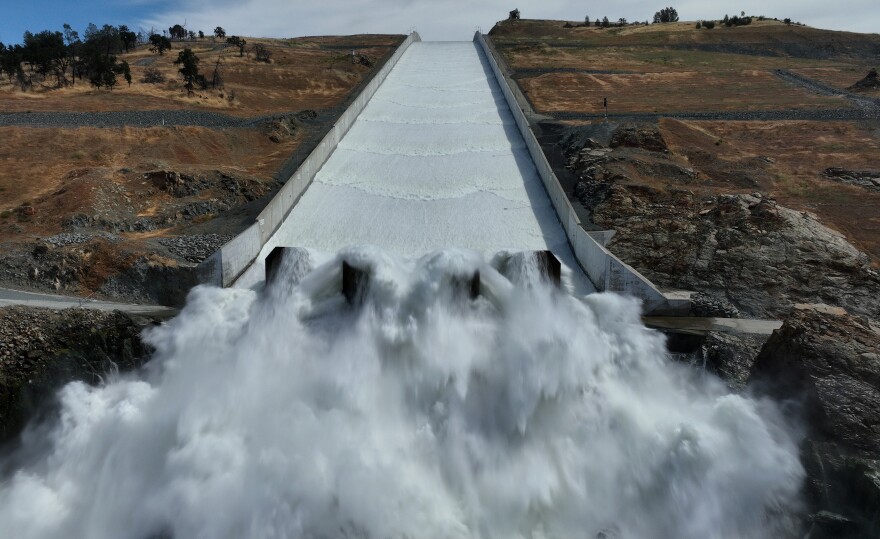With California’s Rainy Season Wrapping Up, Will We See Water Restrictions?

The start of April means that California’s rainy season is coming to an end. Things are looking pretty good this year, but there are some caveats.
The snowpack across the Sierra Nevada and the Colorado River Basin — both critical stores of water — is hovering slightly above average, though it’s nowhere near what we saw last winter.
For comparison, in 2023, the State Water Project (SWP) was able to fulfill 100% of water requests made by municipalities across California. This year, the SWP announced a 30% allocation.
“Last year there was so much water we were looking for every place we could to store some water,” said John Yarbrough, assistant deputy director for the SWP.

A slow start to the rainy season across the Sierra could lead to decreased runoff as the dry ground beneath the snowpack sucks up what it can when everything starts to melt.
Runoff is also dependent on the weather to come. Rainstorms can cause snow to melt faster than anticipated, leading to lower snow levels during the dry months. And high temperatures increase evaporative demand across landscapes, leaving less water for plants, animals and us.

Will there be water restrictions?
It’s looking unlikely, as our reservoirs are quite full and we’ve had a good showing of snow.
“We pulled back on restrictions last year, however, we're telling people to use their common sense,” said Adel Hagekhalil, CEO of the Metropolitan Water District of Southern California.
The public agency will neither be drawing from or putting water into storage, though that’ll change if the allocation increases. According to Hagekhalil, the MWD has enough water to help Southern California get through the next three years.
“Let's not be fooled by a year of rain or two years of rain. This climate whiplash is amongst us, and we're going to see these hotter and drier days coming,” he said.
Some places still struggling to recover from the drought
One consistent message I heard when reaching out for this piece was just how bad of a position the 2020-2023 drought put us in.
“It's really hard with that magnitude of dryness to make up for it with just a few wet years,” said Michael Anderson, state climatologist with the Department of Water Resources.

If you recall, locations like Las Virgenes Municipal Water District in Western Los Angeles County nearly ran out of water. And though Lake Mead got some water last year, levels are still below those seen in 2020.
Groundwater supplies are still stressed, and wells could go dry in some parts of the state — particularly along the Eastern border, which hasn’t seen nearly as much rain as places like Los Angeles.
Landscapes covered in diseased and dead trees (the result of drought), aren’t going to look like they did anytime soon.

“If you look at the soil moisture data, it does indicate that there are still some long term lingering concerns that may or may not ever go away, given the warmer planet that we live on plus the human demands on the water supply as well,” said Brad Rippey, meteorologist with the U.S. Department of Agriculture and contributing author to the U.S. Drought Monitor.
Short-term surface based drought could come back following one miserably dry year. Longer term, deeper drought impacting groundwater and reservoir storage would take a few dry years to return.
The bottom line is that we need to assume that next year will be dry, as erratic precipitation patterns and hotter temperatures are exacerbated by climate change.
-
The state's parks department is working with stakeholders, including the military, to rebuild the San Onofre road, but no timeline has been given.
-
Built in 1951, the glass-walled chapel is one of L.A.’s few national historic landmarks. This isn’t the first time it has been damaged by landslides.
-
The climate crisis is destabilizing cliffs and making landslides more likely, an expert says.
-
Lifei Huang, 22, went missing near Mt. Baldy on Feb. 4 as the first of two atmospheric rivers was bearing down on the region.
-
Since 2021, volunteers have been planting Joshua tree seedlings in the Mojave Desert burn scar. The next session is slated for later this Spring, according to the National Park Service. Just like previous times, a few camels will be tagging along.
-
There are three main meteorological reasons why L.A. is so smoggy — all of which are affected when a rainstorm passes through and brings clearer skies.







